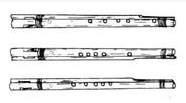General classification
Mr. Yu is a single-reed gas-sounding instrument of the Jingpo and De'ang peoples. In Jingpo language, " Bi" is a general term for air-sounding musical instruments, and "general" is double, which means a pair of air-sounding musical instruments with two pipes juxtaposed. Folks have the same style but different specifications.

Rui Zuo, Ying is the small one. It is made of two bamboo pipes, the main and the auxiliary, which are tied side by side. The main pipe is 26 cm long, the inner diameter of the tail end is 0.8 cm, and there are bamboo joints on the top of the pipe. There is a rectangular blow hole 1 cm long and 0.9 cm wide on the side pipe wall 1 cm below the knot, and the blow hole is sealed. Inlaid with a copper reed, the reed tongue is a 20° sharp triangle, a bamboo stick is placed on each side of the reed frame, and a gap of 1 cm long and 0.2 cm wide is left in the middle as a mouthpiece. The tube body has six (five in the front and one in the back) circular sound holes, and the back hole is the highest sound hole. The length of the pipe tail to the first hole is 4 cm, the first to the second hole is 4 cm, the second to the fifth hole is 2 cm each, the fifth to the back hole is 1 cm, and the distance between the one to five holes and the fifth to the blowing hole is equal. The thin bamboo tube on the main side is the auxiliary tube, the length of the auxiliary tube is 16.5 cm, and the inner diameter of the tube tail is 0.5 cm. There is also a rectangular blow hole near the upper end of the tube and a copper reed is sealed, but the tube body is not. Open the sound hole.
Zhanxi, the one among the generals. It got its name because this musical instrument first came from Zhanxi Township, Yingjiang County. The tube body is made of bamboo and consists of main and auxiliary tubes, and the shape is the same as that of Ruizuo. The length of the main pipe is 27 cm, the inner diameter of the tail end is 1 cm, and the first end is left with a joint. There is a square blow hole on the wall of the tube under the section, and a sharp triangular copper reed is sealed. There are six (the first five) in the middle and lower part of the tube body The latter one) round press sound hole, the hole distance varies. The length of the auxiliary tube is 21 cm, the inner diameter of the tail end is 0.6 cm, and the head end is opened with a blow hole, inlaid with a reed, and no sound hole is opened. The auxiliary pipes are arranged side by side on the left side of the main pipe, and the side of the pipe wall adjacent to the main pipe extends down to be flush with the tail end of the main pipe, and the two pipes are tied together with bamboo strips at both ends. At the end of the head of Zhanxi, a small gourd with both ends cut off is often placed horizontally as a sound resonance tube. From a distance, it looks like a pipe.
筚 grid, 筚 in short the big one. Bamboo double-pipe side-by-side musical instrument, the shape is the same as Ruizuo. The main pipe is 36 cm long, the inner diameter of the tail end is 1.1 cm, and the head end is left with a joint. There is a square blow hole on the side wall of the lower side of the joint, and a sharp triangular copper reed is sealed. There are five circular sound-pressing holes on the front of the tube body, with different hole distances, and a high-pitched sounding hole on the back. The length of the auxiliary tube is 34 cm, the inner diameter of the tail end is 0.6 cm, and the head end is opened with a blow hole, inlaid with a reed, and no sound hole is opened.
 渝公网安备 50010702504639号
渝公网安备 50010702504639号